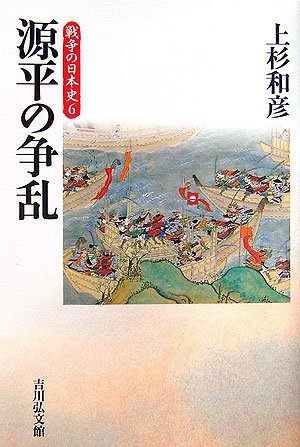13 0 0 0 OA 日本中世法体系成立史論
- 著者
- 上杉和彦 [著]
- 巻号頁・発行日
- 1997
13 0 0 0 鎌倉幕府と官職制度 : 成功制を中心に
- 著者
- 上杉 和彦
- 出版者
- 公益財団法人史学会
- 雑誌
- 史學雜誌 (ISSN:00182478)
- 巻号頁・発行日
- vol.99, no.11, pp.1855-1877, 1970-1971, 1990-11-20
The Kamakura Bakufu from its inception carried out and tried to maintain three fundamental policies concerning its house vassals (gokenin): 1)the prohibition on unlimited official appointments; 2)an emphasis on the jogo 成功 insitution of selling official appointments; and 3)a commitment to continued service in the capital after appointments were made. However, the above three measures should not be regarded as a policy inherent only to the Bakufu, but rather as common to all the bureaucratic institutions urider the ruling elite (kenmon 権門) during those times. However, while these three measures continued to form the Bakufu's basic policy concerning its bureaucracy, amendment no.96 to its Joei Shikimoku 貞永式目 law code, which was promulgated in 1243 by Shogun Minamoto-no-Yoritsune while visiting the capital, contains language that significantly alters the existing customs governing the operation of the jogo institution. This amendment was epoch-making in the sense that efforts were now being made to follow the spirit of the traditional bureaucratic system more strictly than what the Bakufu had done up to that point. The jogo custom as practiced by the Bakufu increased in importance as a means of garnering revenues for the support of the court at Kyoto. However, on the other hand, due to the self-seeking attitudes of the functionaries in charge of selling official appointments, the actual fees paid were often reduced below the officially established rates. This in turn was causing a very unstable flow of funds into the royal treasury. While amendment no.96 quite correctly assesses the actual situation, in the background of its successful promulgation stood the royal court led by Kujono-Michie, who was closely connected to the Kamakura Shoguns. And so in this sense we can see the move to correct jogo practices as part of an overall effort in the movement for mutual cooperation between the aristocracy and the warrior class in controlling the capital bureaucracy. With respect to a bureaucratic polity centering around the jogo institution from this time on, we can observe quite contrasting approaches adopted by the court and the Bakufu. On the one hand, the court showed little initiative in preventing the reduction of fees paid for appointments, while the Bakufu took far more positive steps to insure that such fees were maintained at their official rates. In the background of this positive attitude taken by the Bakufu was the deepening involvement by the Hojo regents in appointing Kamakura house vassals to official positions, a practice that had traditionally been the sole perogative of the Shogun himself.
3 0 0 0 IR 明治大学図書館所蔵『青蓮院文書』--中世文書を中心に
- 著者
- 上杉 和彦 明治大学中世史研究会
- 出版者
- 駿台史学会
- 雑誌
- 駿台史學 (ISSN:05625955)
- 巻号頁・発行日
- no.136, pp.1-20, 2009-03
1 0 0 0 日本中世法体系成立史論
1 0 0 0 摂関院政期の明法家と王朝国家 : 中世公家訴訟制度成立史の一視角
- 著者
- 上杉 和彦
- 出版者
- 公益財団法人史学会
- 雑誌
- 史學雜誌 (ISSN:00182478)
- 巻号頁・発行日
- vol.95, no.11, pp.1726-1750, 1828-1829, 1986-11-20
The final goal of this report is to clarify the conversion of the judicial official function as well. as to identify its causes between the ancient and the medieval ages periods in Japan. Its conclusions run as follows. The main function of judicial officials in the Sekkan Period was to submit names of crimes. A system appeared, in which judicial officials, receiving directions by Imperial command, reported the names of crimes to the Dajohkan. Then, the Jinnosadame decided the names of crimes according to their reports. This means they were the de facto law enforcement agency of the Imperial Administration. Therefore, the government decision of names of crimes required their reports in principle. Another function of judicial officials in this period was to answer legal questions which government agencies asked in order to fulfil their tasks. This second function was gradually expanded to be used by private sectors after the eleventh century. The functions of judicial officials greatly changed in the Insei Period. First, the procedure of submitting names of crimes was gradually formalized. Second, and more importantly, they were coming to have the full-scale function of reporting the merits of lawsuits and disputes. The cause of the latter change is that in this period lawsuits and disputes concerning land beyond the framework of provinces were occurring so frequently. Given that these judicial officials had answered questions on legal principles in the previous period, parties litigant generally came to them for advice. On the basis of this tendency, the Imperial Administration put the reporting function of judicial officials into the national system of lawsuits decisions. Each man of power did the same. This brought about the direct rule of court nobles in the Insei period over the function of judicial officials as law enforcement agencies ; and moreover, accelerated the establishment of the lawsuit decision system, that is, the establishment of the Kirokujo on a larger scale. The Kirokujo was founded as the organization which gathered working officials, including judicial officials who functioned as judicial officials. When we see the Kirokujo and its successor, Fudono, as located in the center of the medieval aristocratic lawsuit system, the reorganization of judicial officials must be assessed as its very beginning.
